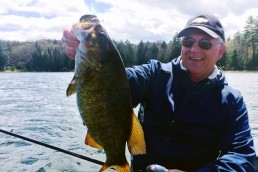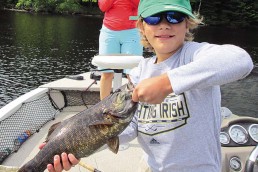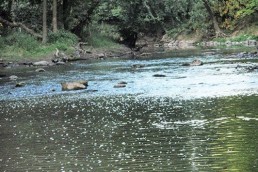Fish Transitions for Big Pre-spawn Smallmouths
SHARE THIS POST
Transition areas can be prime staging spots for big, pre-spawn female smallmouths. As water temperatures rise during the day, females will start to roam the shallows and continue doing so until the sun starts to wane. The falling temperatures then cause it to reverse its procedure. Once the water temperature drops only a few degrees, the female smallmouths begin to move out of the shallows. They will often stack up along the first transition from soft to hard bottom, and on many natural lakes and reservoirs, this is usually a steep, rock shoreline.
Big smallmouths will hold tightly to the steep rock transitions overnight and remain there the next day until the water temperature variation repeats the whole procedure. Even if the transition is not present, smallmouths will use steep rock banks as migration routes from deep to shallow water. Most anglers will launch their boat and head into the shallows and pass up the honey hole. The smart angler will stop at the transition, cast a suspending jerkbait, soft plastic jerkbait, grub, jig and minnow or a crankbait, and start the day with a few big smallmouths.
Don’t make the mistake of passing up the transition in the morning and heading for the shallows. You might catch a few small males while fishing the shallows, and even have some fun, but if the water temperature drops overnight the big fish will not be there. If you wait to fish the transition until late morning, you will also find a lack of big fish. As the day progresses and the water temperature rises a few degrees, the temperature will trigger smallmouths to head back toward the shallows. This might not be a quick movement, and the fish will spread out and be tough to locate, making for tough fishing.
By late afternoon, smallmouths will be back suspending off the edge of the transition and be very catchable. In fact, the first time I caught big smallmouths relating to a transition was in the afternoon when the bite in the shallows had stopped. I had about an hour left on a guide trip and decided to give a steep, rocky shoreline a try, even though I had fished it several times before during the day with little, if any success. I had my client cast a crankbait, hoping to kill some time before heading back to the boat landing, and then bang, after the third cast he connected with a 20-incher, which was the big smallmouth of the day.
No, I did not keep the big fish for last even though my client might have thought that.
At first, I did not dwell on this, thinking that my client had managed to stumble into a “gift fish.” I had the guy booked for the next day, and how could we not make the place where he caught the big fish the day before our first stop. I was hoping that there would be at least one big smallmouth, but to my surprise, my client boated five smallmouths in the 20-inch class. I even got into the act and caught a 20-incher with a grub. Since that time that transition, along with a few others, are a regular morning and afternoon stop on my guide trips.
When the water temperature climbs into the upper 50s or lower 60s, smallmouths enter the late pre-spawn period. At that time, plastics and jerkbaits remain effective, but topwater baits also become effective. Fishing with a topwater bait is never a guarantee that the closer the smallmouths are to spawning, the more predictable the topwater bite is—the topwater bite can be sporadic and you will need to make adjustments.
One May, I had a client that missed several giant smallmouths and both he and I were getting frustrated. I was fishing the used water with a Case Magic Stick rigged wacky-style and hooking my client’s missed smallmouths. Although I was catching them, my client was getting strikes on the Hubs Chub and he was content to keep using the bait. I knew that it was not the Hubs Chub that was missing smallmouths but the overzealous client—a common dilemma for a fishing guide.
Are you enjoying this post?
You can be among the first to get the latest info on where to go, what to use and how to use it!
I approached the situation with caution and suggested he should slow down the bait. Seeing that my client was not responding to my coaching, it was time for an attitude adjustment. As we approached a downed tree, a steady producer of big smallmouths, I positioned the boat in a way that it would be next to impossible for my client to get a good cast at the tree. I quickly grabbed another rod and pitched a bone/shad Hubs Chub tight to the downed tree at the edge of the creek channel. I let the Hubs Chub settle, reeled up the slack and raised my rod about a foot. This caused the Hubs Chub to emit a slight pop. All at once, the water exploded and we both watched a 21-inch smallmouth fly out of the water. My client was mesmerized and did not realize he had been bamboozled.
“How did you do that?” he asked.
“I finessed the bait,” I eagerly replied. “Watch carefully what I do on my next cast.”
I made another cast at the same downed tree, let the Hubs Cub settle, raised my rod again and hooked another big smallmouth. After the smallmouth was released, I handed my client the rod and he repeated my technique. He did not get a strike on that cast, but he continued finessing the bait, and eventually hooked a 19-inch smallmouth.
The rest of the day he caught 14 smallmouths and only missed three. I explained to my client that the Hubs Chub drops vertically in the water and the BB’s in the lure cause it to quiver. An active smallmouth will often hammer the Hubs Chub, but a neutral smallmouth will be attracted to the quivering and suck in the bait and slowly pull it under. There is no way to know how a smallmouth will react to the bait, so the angler needs to be prepared the second the bait hits the water. Popping baits that drop vertically in the water can also work under this situation.
Mike Mladenik is a knowledgeable smallmouth bass fisherman and one of the region’s top guides. Over the past 30 years, his clients have landed over 3,000 20-inch smallmouths and hundreds of hawgs over 6 pounds. For more smallmouth bass tips or Hubs Chub Topwater Bait, go to bigsmallmouthbass.com.
MWO
SHARE THIS POST
Did you enjoy this post?
You can be among the first to get the latest info on where to go, what to use and how to use it!
Mike Mladenik
Mike Mladenik has been guiding for more than 30 years in Northern Wisconsin. Recognized as one of the top smallmouth bass experts in North America, he has boated 4,000+ smallmouth over 5 pounds and a few hundred over 6 pounds. Mike has authored 10 fishing books and gives seminars at sports shows across the Midwest. For more info: bigsmallmouthbass.com or 715-854-2055.



